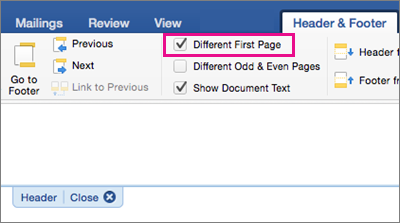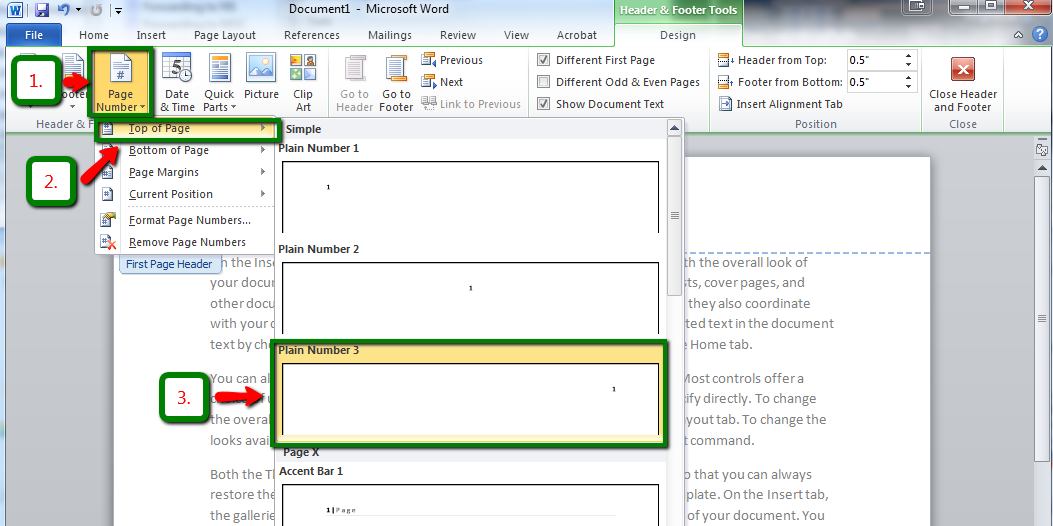
So I type my header into the top of the second page and click Close. In this example, I only want headers on the pages after the first page. The top and bottom of your document are revealed for editing, along with some information and a Close button in blue boxes. ( If your document has sections, you’ll need to experiment here.) Click OK.Ĭlick the View menu and select Header and footer. Under “Headers and footers” check “Different first page.” Make sure this applies to the whole document. The Document dialog displays.Ĭlick the Layout tab of the Document dialog. If you’re on Windows, this short procedure may still be helpful.Ĭlick the Fromat menu and select Document. Instead of ribbons, we can still use menus.

If you’re using Apple’s OSX, you’re in luck. Then they further obfuscate it with “ribbons” of tools that change with every release, and with confusing online help. Microsoft manages to bury this seemingly simple task far away from the creation of headers and page numbers. This is mind-boggling because ultimately all I'm after is a wayfinder akin to "display the current chapter where I'm currently located in the document outline at the point when the reader turned the page and the new header gets generated.A typical manuscript formatting requirement is to number all your pages except for the first one. Here are some of the required actions to do the required tasks: To hide the page. In my experiments so far, it seems the StyleRef syntax alone can only find Heading 1 text that occurs on the same page. Yes, It is possible to put header on selective page in a document on MS Word. By using the buttons located on the Header and Footer toolbar, you can insert the page number, date, or time into the header and/or footer.
Microsoft word for mac different first page header update#
Thus, I'd like the header of page 2 to say "Relevant Professional Experience, continued" or something to that effect (a field coded STYLEREF "Heading 1" plus the text ", continued" seems like it should do the trick) and each subsequent header would dynamically update in the same way for later Headings 1, e.g., "Publications, Presentations, and Appearances" takes up several pages and ideally the heading of each page would tell the reader exactly where they are in the navigation. If you want the same header and footer to appear on every page, create a universal header and footer. Thanks for this great explanation about StyleRef.ĭo you know of a technique for pulling the Heading 1 text from the previous page? For example, page 1 of my CV has a Heading 1 style applied to the text "Relevant Professional Experience." The body text beneath this heading extends onto page 2. NOTE 3: Here's another MS Word article you might be interested in: If you refer to these built-in styles with just their number, it works correctly across all Word language versions. This causes a "style not found" message, because Word tries to find "Heading 1" when that style is now called "Titre 1", for example. to the local language when you switch Word language versions. Word translates the style names of the built-in Heading 1, Heading 2, etc.

NOTE2: If you use different language versions of Word at the same time (the UI language, not the document language), edit the field codes and replace STYLEREF "Heading 1" with STYLEREF 1. One pointing at the number, and the other one pointing at the name. Click on the 'Switch Between Header and Footer' icon to go to either the header or footer in the document. NOTE 1: If you want the chapter number AND chapter name in the same header/footer, insert this field twice. Click on the 'View' option and then click on the 'Header and Footer' option again to bring up the 'Formatting' menu for headers and footers. To insert the chapter number instead, select the Insert paragraph number check box.

Select the Preserve formatting during updates checkbox.In the Style name list, click on Heading 1.


 0 kommentar(er)
0 kommentar(er)
